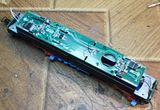EA 060 from Railway Memories
http://trenulete.info/060-ea-de-la-amintiri-feroviare/March came one spring day, arrived in Botosani two wonderful Romanian electricity for interventions and improvements. The first of them, an EA Dolphin, had a disturbing noise curves and move at the same voltage, slightly more slowly than standard painted colors. I noticed when demonatrii, differences in the fastening system, the dolphin with only four points of attachment of the body chassis, while the classic, has 8 points of attachment, which reinforces more than two elements. To remove them easily, you can use a few toothpicks placed near the points of attachment, after which the locomotive back in normal position and is very easy to extract its own weight of the chassis ...

After disassembling and analyzing the Dolphin, I found two shortcomings that produce customer dissatisfaction. The first finding is that if one engine Wheel, placed too close to the engine, just touch the chassis wall, which led to friction, causing some noise and infranand rotation. A second finding, was that the two cardan transmission from dolphin, had casting defects, which are slightly off, which could create annoying vibrations and noise produced by the tremolo ... Also, the ends of the dial, crosses how are called, have a greater stake in the coupling nut, which leads to noise and annoying. Their remedy was made by straightening cardanelor hot and filling with silicone grease coupling nuts. So annoying noise, and speed deficiency decreased significantly by these interventions. As for straightening cardanelor, maybe not all models have this problem, the job holder you and good luck, but opposite ends of the universal joints, grease put in nuts, will probably reduce vibration for a while, but after melting and discharged, noise likely to be established again. There I found the same problems and the classical. This is perfect for cardan, front ends and nuts are combined game so great as to define and Wheel are slightly better placed on the engine axis, which induces the idea that it worked much more responsible than the latest pair, dolphin, or it was simply a bad luck of this Buyer!
For classic locomotive, the requirement was that the owner removes a shortcoming on the lighting. The fact found is that the engine is made by taking into prime interest to holders of digital satisfaction. Lighting scheme comprises four LEDs. Two yellow to white spots and two lights above the cab warm. In both cases, the lights are in series, doaua two, and then with one insriate SMD resistor value of 271 ohms each. Although the scheme has two ways of operation by changing a jamper lights, I believe that it was not designed to function properly in both digital and analog, knowing that inserirea LED current increases the initiation of production of light reflected in the drawback that, in analog and positions lights are lit only at very high speed running, ie the voltages or currents of power over jumatet variable. In the type Mehano I contatat a better, by firing at 30% of tension, while the drives Piko, just over 50% lights are barely, barely. This is quite annoying for the user of analog, quite widespread, that the price needs digitalis, not all collectors can buy the necessary devices. Therefore, after careful analysis of the pattern of operation, we chose an elegant solution that does not involve major changes to the motherboard and that will lead to satisfactory results in the normal operation of lights and analog parameters, given that proper lighting a model, the effect on the viewer grows exponentially.
How we did!
Well, first I changed the jumper position for the headlights only position at both ends, so that the second yellow LED SMD (God knows why they chose this color !!!), position of lights, end up in series with two 271 ohm resistors, a total of 542 ohm ballast.
We then stopped scratching, line plus (+) central headlight, thus eliminating their series-position lights.
I brought a strap which also have central headlamp powered directly, bypassing the headlights inseriarea position.
Since leaving the diode polarity directing, I took a voltage the resistor 580 through IMO, which I applied to the minus two of the SMD and central headlamp so I fed identical in each ballast resistance different but similar in value, each group of lighting, both top and bottom.
Thus, the two groups came to light with the same value of red light, which worked perfectly before surgery, and at this moment, the light became operational in the analog voltage values close to starting time. Aprid mean is applied relatively quickly to lower tensions toy, releasing a pretty obvious drawback for owners of analog. I think that could solve the problem of manufacturing by implementing a simple scheme based on the jumpers, which will satisfy both categories of clients, but probably the economic nature of the producer, that spare parts would lead to increased price toy. But I think it would be justified, considering the fact that there are many similar users who love this beautiful locomotive, with whom we Romans, I grew up and we traveled on railroads in Romania during all these years and that trains an unspeakable passionate love.
